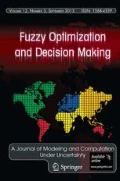Abstract
This paper presents a bilevel fuzzy principal-agent model for optimal nonlinear taxation problems with asymmetric information, in which the government and the monopolist are the principals, the consumer is their agent. Since the assessment of the government and the monopolist about the consumer’s taste is subjective, therefore, it is reasonable to characterize this assessment as a fuzzy variable. What’s more, a bilevel fuzzy optimal nonlinear taxation model is developed with the purpose of maximizing the expected social welfare and the monopolist’s expected welfare under the incentive feasible mechanism. The equivalent model for the bilevel fuzzy optimal nonlinear taxation model is presented and Pontryagin maximum principle is adopted to obtain the necessary conditions of the solutions for the fuzzy optimal nonlinear taxation problems. Finally, one numerical example is given to illustrate the effectiveness of the proposed model, the results demonstrate that the consumer’s purchased quantity not only relates with the consumer’s taste, but also depends on the structure of the social welfare.
Similar content being viewed by others
References
Bierbrauer F. (2009) A note on optimal income taxation, public goods provision and robust mechanism design. Journal of Public Economics 93: 667–670
Boadway R., Gahvari F. (2006) Optimal taxation with consumption time as a leisure or labor substitute. Journal of Public Economics 90: 1851–1878
Cui L., Zhao R., Tang W. (2007) Principal-agent problem in a fuzzy environment. IEEE Transactions on Fuzzy Systems 15: 1230–1237
Casas E., Mateos M., Raymond J. P. (2001) Pontryagin’s principle for the control of parabolic equations with gradient state constraints. Nonlinear Analysis 46: 933–956
Costantino F., Di Gravio G. (2009) Multistage bilateral bargaining model with incomplete information-A fuzzy approach. International Journal of Production Economics 117: 235–243
Chen C. M. (2009) A fuzzy-based decision-support model for rebuy procurement. International Journal of Production Economics 122: 714–724
Gibbard A. (1973) Manipulation of voting schemes: a general result. Econometrica 41: 587–602
Huang X. X. (2009) A review of credibilistic portfolio selection. Fuzzy Optimization and Decision Making 8: 263–281
Hamilton J., Slutsky S. (2007) Optimal nonlinear income taxation with a finite population. Journal of Economic Theory 132: 548–556
Ke H., Ma W., Gao X., Xu W. (2010) New fuzzy models for time-cost trade-off problem. Fuzzy Optimization and Decision Making 9: 219–231
Laffont J. J. (1987) Optimal taxation of a non-linear pricing monopolist. Journal of Public Economics 33: 137–155
Liu B., Liu Y. K. (2002) Expected value of fuzzy variable and fuzzy expected value models. IEEE Transactions on Fuzzy Systems 10: 445–450
Liu B. (2002) Theory and practice of uncertain programming. Physica-Verlag, Heidelberg, Germany
Liu B. (2006) A survey of credibility theory. Fuzzy Optimization and Decision Making 5: 387–408
Lan Y., Liu Y. K., Sun G. J. (2009) Modeling fuzzy multi-period production planning and sourcing problem with credibility service levels. Journal of Computational and Applied Mathematics 231: 208–221
Lan Y., Liu Y. K., Sun G. J. (2010) An approximation-based approach for fuzzy multi-period production planning problem with credibility objective. Applied Mathematical Modelling 34: 3202–3215
Luhandjula M. K. (2007) Fuzzy mathematical programming: theory, applications and extension. Journal of Uncertain Systems 1: 124–136
Moresi S. (1998) Optimal taxation and firm formation: A model of asymmetric information. European Economic Review 42: 1525–1551
Mirrlees J. (1971) An exploration in the theory of optimum income taxation. Review of Economic Studies 38: 175–208
Nahmias S. (1978) Fuzzy variables. Fuzzy Sets and Systems 1: 97–110
Pedrycz W. (2007) Granular computing—the emerging paradigm. Journal of Uncertain Systems 1: 38–61
Parker S. C. (1999) The optimal linear taxation of employment and self-employment incomes. Journal of Public Economics 73: 107–123
Sun G. J., Liu Y. K., Lan Y. (2010) Optimizing material procurement planning problem by two-stage fuzzy programming. Computers and Industrial Engineering 58: 97–107
Tanaka H., Guo P., Zimmermann H. J. (2000) Possibility distribution of fuzzy decision variables obtained from possibilistic linear programming problems. Fuzzy Sets and Systems 113: 323–332
Wang C., Tang W., Zhao R. (2007) On the continuity and convexity analysis of the expected value function of a fuzzy mapping. Journal of Uncertain Systems 1: 148–160
Xue F., Tang W., Zhao R. (2008) The expected value of a function of a fuzzy variable with a continuous membership function. Computers and Mathematics with Applications 55: 1215–1224
Zimmermann H. J. (1985) Applications of fuzzy set theory to mathematical programming. Information Sciences 36: 29–58
Zadeh L. A. (1965) Fuzzy sets. Information and Control 8: 338–353
Author information
Authors and Affiliations
Corresponding author
Rights and permissions
About this article
Cite this article
Lan, Y., Zhao, R. & Tang, W. A bilevel fuzzy principal-agent model for optimal nonlinear taxation problems. Fuzzy Optim Decis Making 10, 211–232 (2011). https://doi.org/10.1007/s10700-011-9103-8
Published:
Issue Date:
DOI: https://doi.org/10.1007/s10700-011-9103-8




